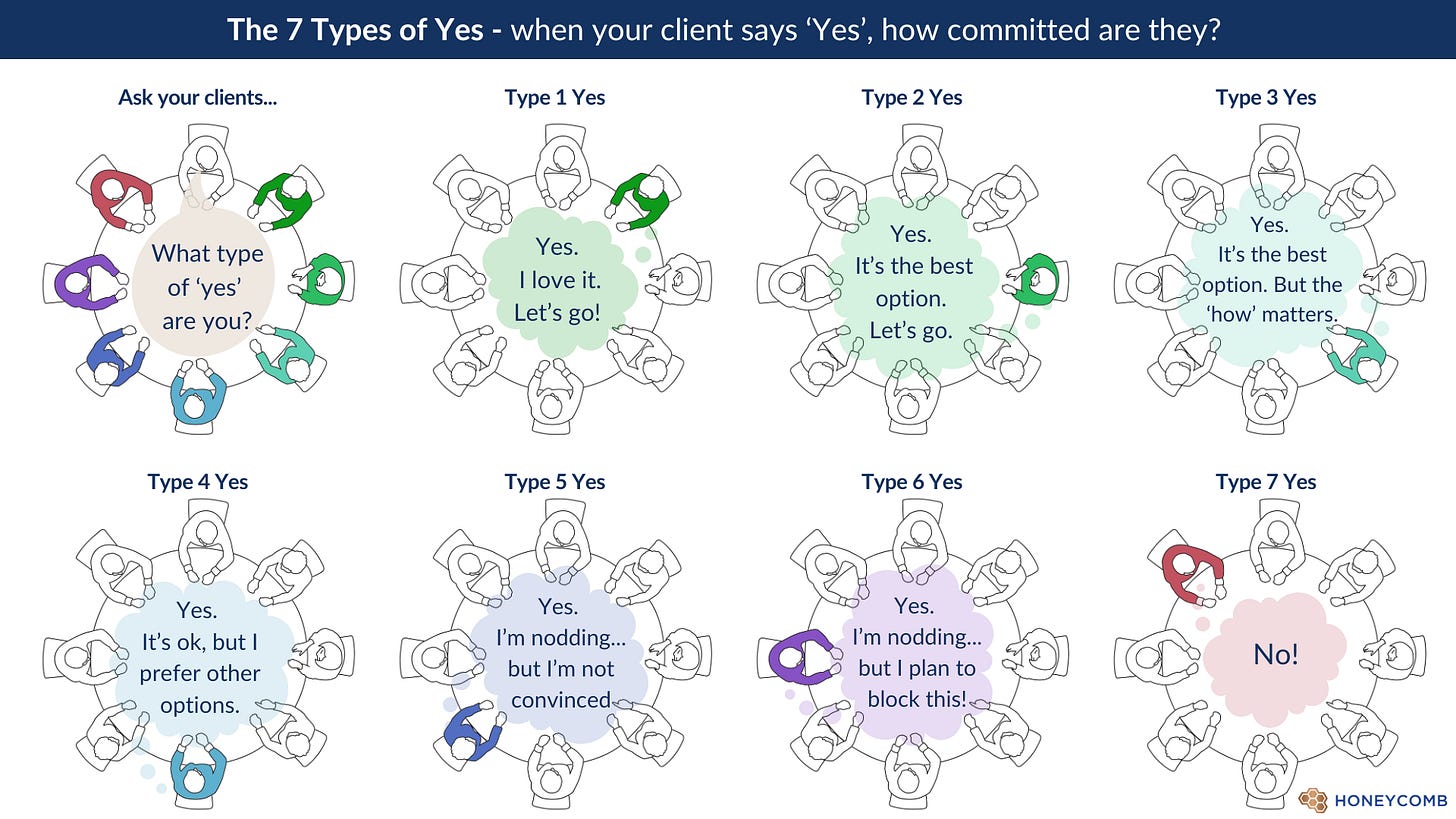Agreement isn't the same as commitment
Why your team might be nodding along but nothing is changing
I’ve been talking to two different clients recently who share a similar goal: they want to drive more collaboration across different parts of their business.
Both organisations have grown into multi-practice firms. They go to market with a range of propositions, often quite distinct from one another. And within each part of the business, individual partners are rightly focused on growing their area — building client relationships, selling work, delivering value.
But now, the firm-wide goal is shifting. There’s a push to collaborate across units. Share clients. Co-create propositions. Present a more joined-up front to the market. Not just to grow revenue, but to grow equity value too. Because, if you can show your business is greater than the sum of its parts, valuation multiples improve, and future investors get more confident in what they’re buying into.
The strategic rationale makes total sense. And in most firms, people agree with it, at least in principle. But agreement isn’t the same as commitment.
In both client conversations, we got to a similar sticking point.
When collaboration is positioned as a top-down priority, there’s inevitably a lot of polite nodding around the table.
“Yes, yes, of course we’ll do that. We’ll share opportunities. We’ll build joint propositions.”
And then…it doesn’t happen.
Not because people are being obstructive, but because they’re not actually bought in. They’re still focused on what’s already working in their own part of the business. And in many cases, they’re still being incentivised to do exactly that.
‘Yes’ often doesn’t mean ‘yes’
In one recent session, we used a simple tool I’ve brought into leadership teams many times before: the Seven Types of Yes.
It’s a way of naming the different kinds of agreement we give and spotting when we (or someone else at the table) are saying yes, but actually mean something else. Here’s what each type of yes really means:
Yes 1: I love it. I’m totally in.
Yes 2: It’s the best option. I get it.
Yes 3: I understand the logic, but I’m not energised.
Yes 4: I’ll go along with it… but it’s not my preferred choice.
Yes 5–7: Varying degrees of I’m saying yes but I’m not going to do it.
Much like NPS, only the top two scores really count. Anything less than that and it’s a fair bet that not a lot is going to change on the back of the conversation. If anyone is down in the 6s or 7s you have a detractor on your hands who could actively derail things.
When I used this tool with my clients recently, the responses were candid.
“I’m probably at a Yes 3 or 4.”
They agreed in principle, but they weren’t trying to make it happen. Making it safe to get this on the table and being able to facilitate a discussion from there is a hugely valuable unlock.
Where do you go from there?
The real conversation leadership teams need to have is not, “Do we all agree then?” but, “What kind of yes are we actually giving?”
If you’re sitting around the table with a mix of 3s and 4s, there are two honest paths:
Say, “We’re not truly committed to this right now”, and stop pretending.
Or, do what it takes to get to a Yes 1 and build from there.
That might mean restructuring incentives. It might mean revisiting how trust is built across the firm. It might mean something else entirely.
If you’re trying to drive collaboration across your business, or you are struggling to get traction with a client, try these questions at your next meeting:
“Where are we, honestly, on the Seven Types of Yes? What would it take for more of us to get to a Yes 1 or 2?”
Until you surface what’s real, you can’t hope to shift it.
Thank you for reading The Skilled Consultant. If you haven’t yet subscribed, please do so to receive all our articles direct to your inbox.
There are several other ways you can interact with Honeycomb Consulting Skills Training….
Connect with Deri Hughes (Founder & MD) on LinkedIn
Connect with Colin Mann (MD) on LinkedIn
Book a 30 minute intro call with Deri Hughes
Stay informed about our free workshops and webinars - follow Honeycomb on LinkedIn or visit our website.





This is a great exercise to work through with a group! But I wonder if it couldn't be simplified to Yes/No on 1) direction and 2) approach. The 'how' (approach) is ALWAYS going to matter, and I find where most of the friction comes from. Moreover, being able to specify how each person in the conversation contributes to the 'how' should get to the reality of their commitment very quickly. "Great, so we're all in agreement that it's time to find a new consulting partner for our Sales and Marketing. Let's breakdown how we best go about that, and who needs to own what... <after the approach discussion>... Linda, that means you're on the hook for creating the shortlist of potential partners by end of next week. How do you feel about that?"
Finally, having a rapport with the players and being in person so their body language is readable has become under appreciated in recent years. If you have familiarity and you're in the room with them, you will be able to 'read' their level of commitment far better than over video (or certainly only audio). THEN, if there's still doubt, immediately breakaway and have a heart to heart to discuss with the concerned party to shortcut potential issues quickly.